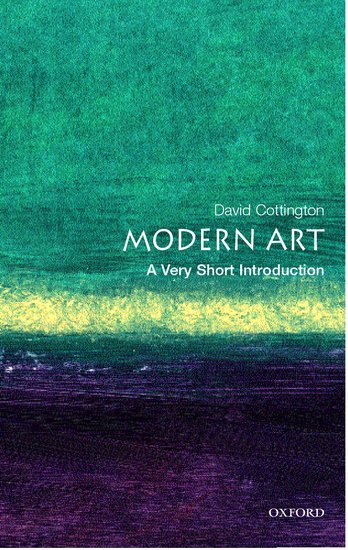Home >
A Very Short Introduction >
Modern Art (Art)
A Very Short Introduction | Art
Modern Art
ISBN: 9780192803641
Series: A Very Short Introduction
Modern Art (Art)
A Very Short Introduction Modern Art (Art) Media > Books > Non-Fiction > Education Books Expect Delays of Up to 4 Weeks| Order Below |
ISBN
9780192803641 (10-digit ISBN: 0192803646)
- Description
- Key Features
- Series Description
- Table of Contents
- Much-needed, accessible approach that grapples clearly and provocatively with the complex idea of modern art
- Cottington is the author of the best-selling book, Cubism
- The book covers all main artists and movements, as well as the new developments in modern art
- Examines key aspects of modern art using examples such as Manet's Dejeuner sur L'Herbe(1863) to Picasso's Les Demoiselles, and Tracey Emin's Bed (1999)
- Looks at the role of the art dealer, from the main Cubist dealer, Kahnweiler to Charles Saatchi
As public interest in modern art continues to grow, as witnessed by the spectacular success of Tate Modern and the Bilbao Guggenheim, there is a real need for a book that will engage general readers, offering them not only information and ideas about modern art, but also explaining its contemporary relevance and history. This book achieves all this and focuses on interrogating the idea of 'modern' art by asking such questions as: What has made a work of art qualify as modern (or fail to)? How has this selection been made? What is the relationship between modern and contemporary art? Is 'postmodernist' art no longer modern, or just no longer modernist - in either case, why, and what does this claim mean, both for art and the idea of 'the modern'?Cottington examines many key aspects of this subject, including the issue of controversy in modern art, from Manet's Dejeuner sur L'Herbe (1863) to Picasso's Les Demoiselles, and Tracey Emin's Bed, (1999); and the role of the dealer from the main Cubist art dealer Kahnweiler to Charles Saatchi.
Oxford's Very Short Introductions series offers concise and original introductions to a wide range of subjects--from Islam to Sociology, Politics to Classics, Literary Theory to History, and Archaeology to the Bible.
Not simply a textbook of definitions, each volume in this series provides trenchant and provocative--yet always balanced and complete--discussions of the central issues in a given discipline or field. Every Very Short Introduction gives a readable evolution of the subject in question, demonstrating how the subject has developed and how it has influenced society. Eventually, the series will encompass every major academic discipline, offering all students an accessible and abundant reference library.
Whatever the area of study that one deems important or appealing, whatever the topic that fascinates the general reader, the Very Short Introductions series has a handy and affordable guide that will likely prove indispensable.
Please note: As this series is not ELT material, these titles are not subject to discount.
Introduction
Introduction: Modern Art: Monument or Mockery?
1: The formation of the Avant-Garde
2: New media, new messages
3: Somebody had to be Picasso: the artist as hero
4: High and Low: culture and consumerism
5: Past the post: whatever next?
As public interest in modern art continues to grow, as witnessed by the spectacular success of Tate Modern and the Bilbao Guggenheim, there is a real need for a book that will engage general readers, offering them not only information and ideas about modern art, but also explaining its contemporary relevance and history. This book achieves all this and focuses on interrogating the idea of 'modern' art by asking such questions as: What has made a work of art qualify as modern (or fail to)? How has this selection been made? What is the relationship between modern and contemporary art? Is 'postmodernist' art no longer modern, or just no longer modernist - in either case, why, and what does this claim mean, both for art and the idea of 'the modern'?Cottington examines many key aspects of this subject, including the issue of controversy in modern art, from Manet's Dejeuner sur L'Herbe (1863) to Picasso's Les Demoiselles, and Tracey Emin's Bed, (1999); and the role of the dealer from the main Cubist art dealer Kahnweiler to Charles Saatchi.
Key Features
- Much-needed, accessible approach that grapples clearly and provocatively with the complex idea of modern art
- Cottington is the author of the best-selling book, Cubism
- The book covers all main artists and movements, as well as the new developments in modern art
- Examines key aspects of modern art using examples such as Manet's Dejeuner sur L'Herbe(1863) to Picasso's Les Demoiselles, and Tracey Emin's Bed (1999)
- Looks at the role of the art dealer, from the main Cubist dealer, Kahnweiler to Charles Saatchi
Series Description
Oxford's Very Short Introductions series offers concise and original introductions to a wide range of subjects--from Islam to Sociology, Politics to Classics, Literary Theory to History, and Archaeology to the Bible.
Not simply a textbook of definitions, each volume in this series provides trenchant and provocative--yet always balanced and complete--discussions of the central issues in a given discipline or field. Every Very Short Introduction gives a readable evolution of the subject in question, demonstrating how the subject has developed and how it has influenced society. Eventually, the series will encompass every major academic discipline, offering all students an accessible and abundant reference library.
Whatever the area of study that one deems important or appealing, whatever the topic that fascinates the general reader, the Very Short Introductions series has a handy and affordable guide that will likely prove indispensable.
Please note: As this series is not ELT material, these titles are not subject to discount.
EASY ORDER FORM
PRICES LISTED INCLUDE CONSUMPTION TAX
Price Before Tax:
¥1,790


